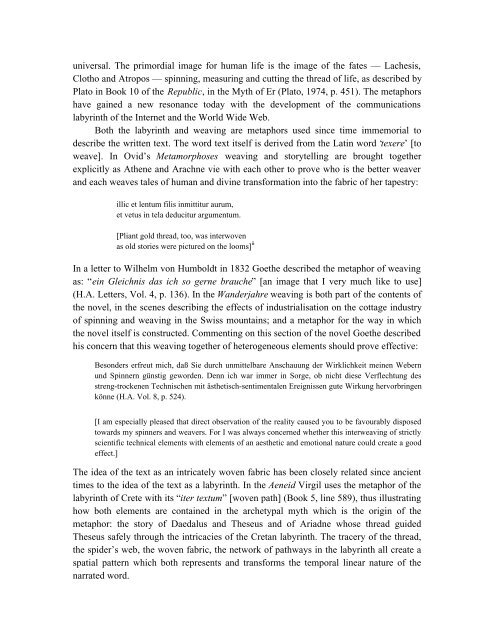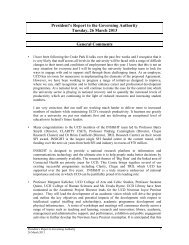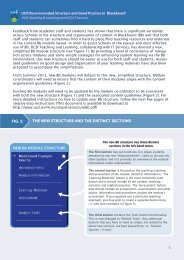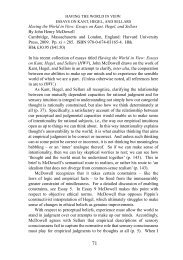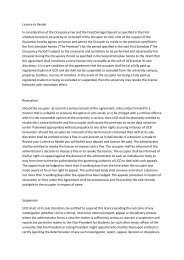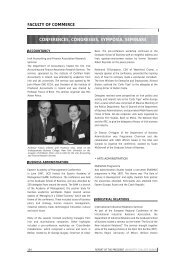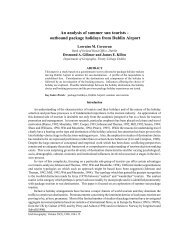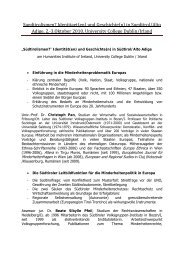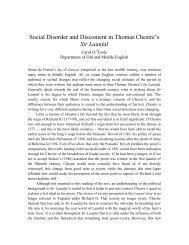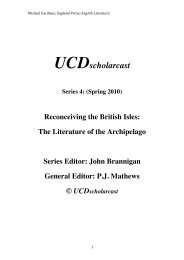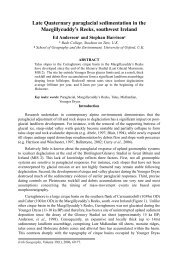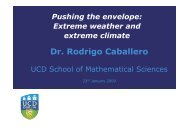Weaving the labyrinth of the text — the novel poetics of Goethe's ...
Weaving the labyrinth of the text — the novel poetics of Goethe's ...
Weaving the labyrinth of the text — the novel poetics of Goethe's ...
Create successful ePaper yourself
Turn your PDF publications into a flip-book with our unique Google optimized e-Paper software.
universal. The primordial image for human life is <strong>the</strong> image <strong>of</strong> <strong>the</strong> fates <strong>—</strong> Lachesis,<br />
Clotho and Atropos <strong>—</strong> spinning, measuring and cutting <strong>the</strong> thread <strong>of</strong> life, as described by<br />
Plato in Book 10 <strong>of</strong> <strong>the</strong> Republic, in <strong>the</strong> Myth <strong>of</strong> Er (Plato, 1974, p. 451). The metaphors<br />
have gained a new resonance today with <strong>the</strong> development <strong>of</strong> <strong>the</strong> communications<br />
<strong>labyrinth</strong> <strong>of</strong> <strong>the</strong> Internet and <strong>the</strong> World Wide Web.<br />
Both <strong>the</strong> <strong>labyrinth</strong> and weaving are metaphors used since time immemorial to<br />
describe <strong>the</strong> written <strong>text</strong>. The word <strong>text</strong> itself is derived from <strong>the</strong> Latin word ‘texere’ [to<br />
weave]. In Ovid’s Metamorphoses weaving and storytelling are brought toge<strong>the</strong>r<br />
explicitly as A<strong>the</strong>ne and Arachne vie with each o<strong>the</strong>r to prove who is <strong>the</strong> better weaver<br />
and each weaves tales <strong>of</strong> human and divine transformation into <strong>the</strong> fabric <strong>of</strong> her tapestry:<br />
illic et lentum filis inmittitur aurum,<br />
et vetus in tela deducitur argumentum.<br />
[Pliant gold thread, too, was interwoven<br />
as old stories were pictured on <strong>the</strong> looms] iii<br />
In a letter to Wilhelm von Humboldt in 1832 Goe<strong>the</strong> described <strong>the</strong> metaphor <strong>of</strong> weaving<br />
as: “ein Gleichnis das ich so gerne brauche” [an image that I very much like to use]<br />
(H.A. Letters, Vol. 4, p. 136). In <strong>the</strong> Wanderjahre weaving is both part <strong>of</strong> <strong>the</strong> contents <strong>of</strong><br />
<strong>the</strong> <strong>novel</strong>, in <strong>the</strong> scenes describing <strong>the</strong> effects <strong>of</strong> industrialisation on <strong>the</strong> cottage industry<br />
<strong>of</strong> spinning and weaving in <strong>the</strong> Swiss mountains; and a metaphor for <strong>the</strong> way in which<br />
<strong>the</strong> <strong>novel</strong> itself is constructed. Commenting on this section <strong>of</strong> <strong>the</strong> <strong>novel</strong> Goe<strong>the</strong> described<br />
his concern that this weaving toge<strong>the</strong>r <strong>of</strong> heterogeneous elements should prove effective:<br />
Besonders erfreut mich, daß Sie durch unmittelbare Anschauung der Wirklichkeit meinen Webern<br />
und Spinnern günstig geworden. Denn ich war immer in Sorge, ob nicht diese Verflechtung des<br />
streng-trockenen Technischen mit äs<strong>the</strong>tisch-sentimentalen Ereignissen gute Wirkung hervorbringen<br />
könne (H.A. Vol. 8, p. 524).<br />
[I am especially pleased that direct observation <strong>of</strong> <strong>the</strong> reality caused you to be favourably disposed<br />
towards my spinners and weavers. For I was always concerned whe<strong>the</strong>r this interweaving <strong>of</strong> strictly<br />
scientific technical elements with elements <strong>of</strong> an aes<strong>the</strong>tic and emotional nature could create a good<br />
effect.]<br />
The idea <strong>of</strong> <strong>the</strong> <strong>text</strong> as an intricately woven fabric has been closely related since ancient<br />
times to <strong>the</strong> idea <strong>of</strong> <strong>the</strong> <strong>text</strong> as a <strong>labyrinth</strong>. In <strong>the</strong> Aeneid Virgil uses <strong>the</strong> metaphor <strong>of</strong> <strong>the</strong><br />
<strong>labyrinth</strong> <strong>of</strong> Crete with its “iter <strong>text</strong>um” [woven path] (Book 5, line 589), thus illustrating<br />
how both elements are contained in <strong>the</strong> archetypal myth which is <strong>the</strong> origin <strong>of</strong> <strong>the</strong><br />
metaphor: <strong>the</strong> story <strong>of</strong> Daedalus and Theseus and <strong>of</strong> Ariadne whose thread guided<br />
Theseus safely through <strong>the</strong> intricacies <strong>of</strong> <strong>the</strong> Cretan <strong>labyrinth</strong>. The tracery <strong>of</strong> <strong>the</strong> thread,<br />
<strong>the</strong> spider’s web, <strong>the</strong> woven fabric, <strong>the</strong> network <strong>of</strong> pathways in <strong>the</strong> <strong>labyrinth</strong> all create a<br />
spatial pattern which both represents and transforms <strong>the</strong> temporal linear nature <strong>of</strong> <strong>the</strong><br />
narrated word.


